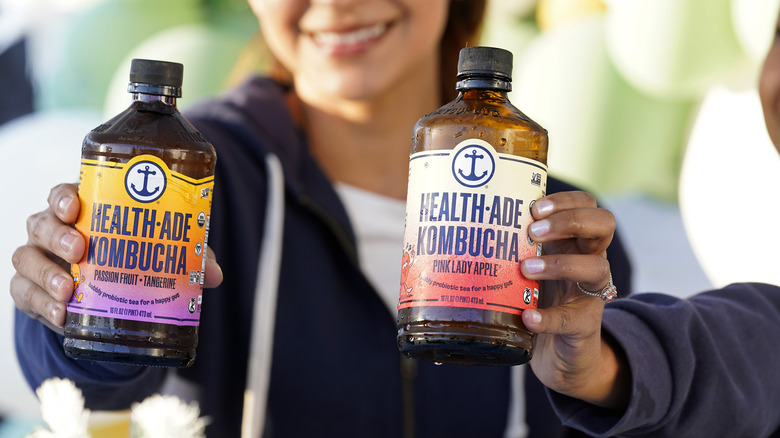How Long Does Store-Bought, Opened Kombucha Last In The Fridge?
Kombucha is fermented tea, so it can't go bad ... right? Wrong. While it's true that kombucha's fermentation gives it a long shelf life, it's far from infinite. Kombucha is loaded with live bacterial cultures, and drinking your bev' during peak freshness ensures the highest quality, strongest potency, and brightest flavor.
In general, shelf life depends on proper storage and time of opening. Unopened and kept in the fridge, store-bought kombucha can last for one to two months. This will be the "expiration date" printed on the bottle. However, once you open that bottle, the game changes. After opening, if kept in the fridge, store-bought kombucha will last for up to a week. Over time, the live cultures in the bottle interact with the air and the fizziness fades. After a week, your kombucha still might technically be safe to drink, but its quality and probiotic properties will have diminished.
For maximum longevity, always keep kombucha in the fridge. The bacteria are alive and require a stable environment — a consistent 40 degrees Fahrenheit is ideal, so stash that bottle in the fridge and keep it there. Don't leave it out overnight, or expect a brief stint in the fridge to rescue it. Also, store your kombucha in an airtight container — the bottle it came in will do just fine. If your store-bought kombucha came in a can, transfer it to a mason jar or other resealable container before refrigerating.
After a week, start inspecting your brew
Kombucha's fermentation and naturally high acidity make it tough for any harmful microorganisms to live or grow. Still, it's possible, and it's important to know the signs of spoilage so folks can keep themselves safe. Spoiled kombucha exhibits a vinegary taste, visible mold, excessive cloudiness, and a thick or slimy consistency. Floating sediments are natural for kombucha, but it can be tough to distinguish normal SCOBY from mold formations. Fuzzy patches and surface discoloration are no bueno. If the floating sediments are green or pink, that's also likely a sign of mold growth.
Some tartness is to be expected from the intermingling of the bacteria and yeast (the tangy zest is the best part!), but, you'll know the difference if your kombucha tastes abnormal or has an off-putting flavor. Trust your senses. Also, give it a good whiff. If you notice a potent alcohol smell or excessive foam, that's also a sign to toss it out. Increased carbonation and acidity levels are caused by the deterioration of the live cultures in the tea, aka unwelcome fermentation.
Of course, different rules apply to homemade kombucha, which isn't commercially sealed and likely subject to idiosyncratic differences that affect the longevity of an individual batch. Even different store-bought brands have unique shelf lives. But, on a positive note, if your kombucha tastes ultra-vinegary but has no signs of mold growth, you can use it as a vinegar substitute for cooking rather than tossing it out (hooray for a zero-waste kitchen!).

